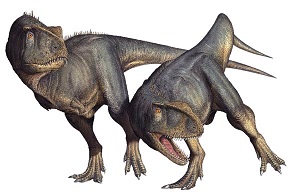
Rugops is a fascinating and enigmatic dinosaur from the Late Cretaceous period, approximately 95 million years ago. This theropod dinosaur belongs to a group known as the Abelisauridae, characterized by their short, deep skulls and often diminutive forelimbs. Rugops offers a glimpse into the diverse world of theropod dinosaurs and the unique adaptations that evolved among these carnivorous giants. In this exploration, we delve deep into the world of Rugops, uncovering its distinctive features, habitat, discovery, and its place in the tapestry of prehistoric life.
Rugops is primarily known from fossilized cranial remains, which reveal some of its distinct features. Its name, which means wrinkle face is derived from the rugose texture of its skull bones. This texture suggests that Rugops had a scaly or bumpy appearance on its face.
Rugops' skull was relatively short and deep, a characteristic shared with other abelisaurids. Its jaws were lined with serrated teeth, indicating a carnivorous diet. While the forelimbs of Rugops were likely small, as is typical of abelisaurids, they played a role in grasping and manipulating prey.
| Name: | Rugops dinosaurs |
| Size: | Around 15 feet (4.5 meters) in length. |
| Main Facts: | Rugops is distinguished by its rugged skull and serrated teeth, signifying its role as a carnivorous predator in Late Cretaceous Africa. |
Rugops was a relatively small theropod dinosaur, estimated to have reached lengths of about 15 feet (4.5 meters) and stood about 3-4 feet tall at the hips. Its size made it a medium-sized predator compared to some of the larger theropods of its time.
As a carnivore, Rugops likely preyed on smaller dinosaurs, reptiles, and possibly scavenged carcasses. Its strong jaws and serrated teeth would have been effective tools for capturing and processing prey.

Fossils of Rugops have been discovered in the Sahara Desert of Africa, specifically in Niger. During the Late Cretaceous, this region was not the arid desert we see today but rather a lush, tropical environment with diverse flora and fauna. Rugops shared this ecosystem with various other dinosaurs, including long-necked sauropods, predatory theropods, and armored dinosaurs.
Rugops was first described by paleontologist Paul Sereno in 2004 based on fossilized skull fragments and other skeletal elements found in Niger. Its classification within the Abelisauridae group places it among a diverse array of theropod dinosaurs known for their stout skulls and unique adaptations.
While specific behaviors of Rugops remain speculative due to limited fossil evidence, it is likely that it exhibited typical theropod hunting and scavenging behaviors. Its relatively small size and robust skull suggest it was well-suited for preying on smaller vertebrates, as well as possibly scavenging larger carcasses when the opportunity arose.
Rugops contributes to our understanding of theropod diversity during the Late Cretaceous, particularly in regions like Africa where dinosaur fossils are less commonly found compared to other continents. It underscores the presence of medium-sized predators alongside the larger carnivores of its time.
Rugops, like many other dinosaurs, met its end at the close of the Cretaceous period, approximately 65 million years ago. The causes of the mass extinction event that wiped out the dinosaurs remain a subject of scientific study and debate.
Rugops is a Late Cretaceous theropod dinosaur known for its short, deep skull adorned with serrated teeth. Its fossils were found in Niger, Africa. Rugops measured about 15 feet (4.5 meters) in length and stood approximately 3-4 feet tall at the hips. This carnivorous dinosaur sported a bumpy or rugose texture on its skull bones, giving it its name, which means "wrinkle face."
While Rugops likely had small forelimbs, it was adapted for grasping and manipulating prey. It played a role as a medium-sized predator in the lush, tropical ecosystems of its time, alongside various other dinosaurs and reptiles.
Rugops had a short, deep skull with serrated teeth, a characteristic shared with some other theropods like the abelisaurids. This adaptation likely served in hunting and processing prey.
Rugops was a medium-sized theropod, contrasting with larger predators like Spinosaurus or Tyrannosaurus rex. Its size placed it in a different ecological niche within Late Cretaceous ecosystems.
Rugops lived in Africa, particularly in Niger, whereas many other theropods were found on different continents. This highlights regional variations in dinosaur fauna.
Rugops is classified within the Abelisauridae group, making it a relative of other abelisaurids like Carnotaurus and Majungasaurus, known for their unique adaptations.
While Rugops' behavior is speculative, its size suggests it preyed on smaller vertebrates, differing from large apex predators that dominated their ecosystems.
Rugops lacked the elaborate crests or ornaments seen in some other theropods like Dilophosaurus or Allosaurus, focusing instead on its robust skull for hunting.
Rugops, like other theropods, was a carnivore, but its prey preferences and hunting strategies may have differed from those of other theropods due to its unique skull adaptations.
Rugops' presence in Africa adds to the understanding of dinosaur distribution, complementing discoveries in South America, North America, and Asia.
Rugops, like most dinosaurs, went extinct at the end of the Cretaceous period. The causes of this mass extinction event affected dinosaur groups globally.